BMP6001 Dissertation Proposal: Impact of Pandemic on Italy Tourism
VerifiedAdded on 2023/06/17
|15
|3033
|96
Dissertation
AI Summary
This research proposal aims to analyze the impact of the COVID-19 pandemic on Italian tourism, focusing on the challenges and recovery strategies. It begins by providing background information on the Italian tourism sector and the impact of the pandemic, highlighting the decline in international arrivals and the economic consequences. The proposal outlines key research questions related to the determinants of Italian tourism, the reasons for its decline during the pandemic, and the steps taken for recovery. The research methodology includes a deductive approach, utilizing surveys and secondary data analysis. Ethical considerations are addressed, ensuring participant consent and minimizing harm. The proposal also includes a timeline, expected outcomes, and limitations, aiming to contribute to the understanding of how Italian tourism management has responded to the pandemic. The literature review covers the determinants of Italian tourism, the impact of COVID-19, and the measures taken for recovery, emphasizing the need for innovative solutions and adaptation to changing tourist demands. The document concludes with references and an ethics form, demonstrating a comprehensive approach to the research.
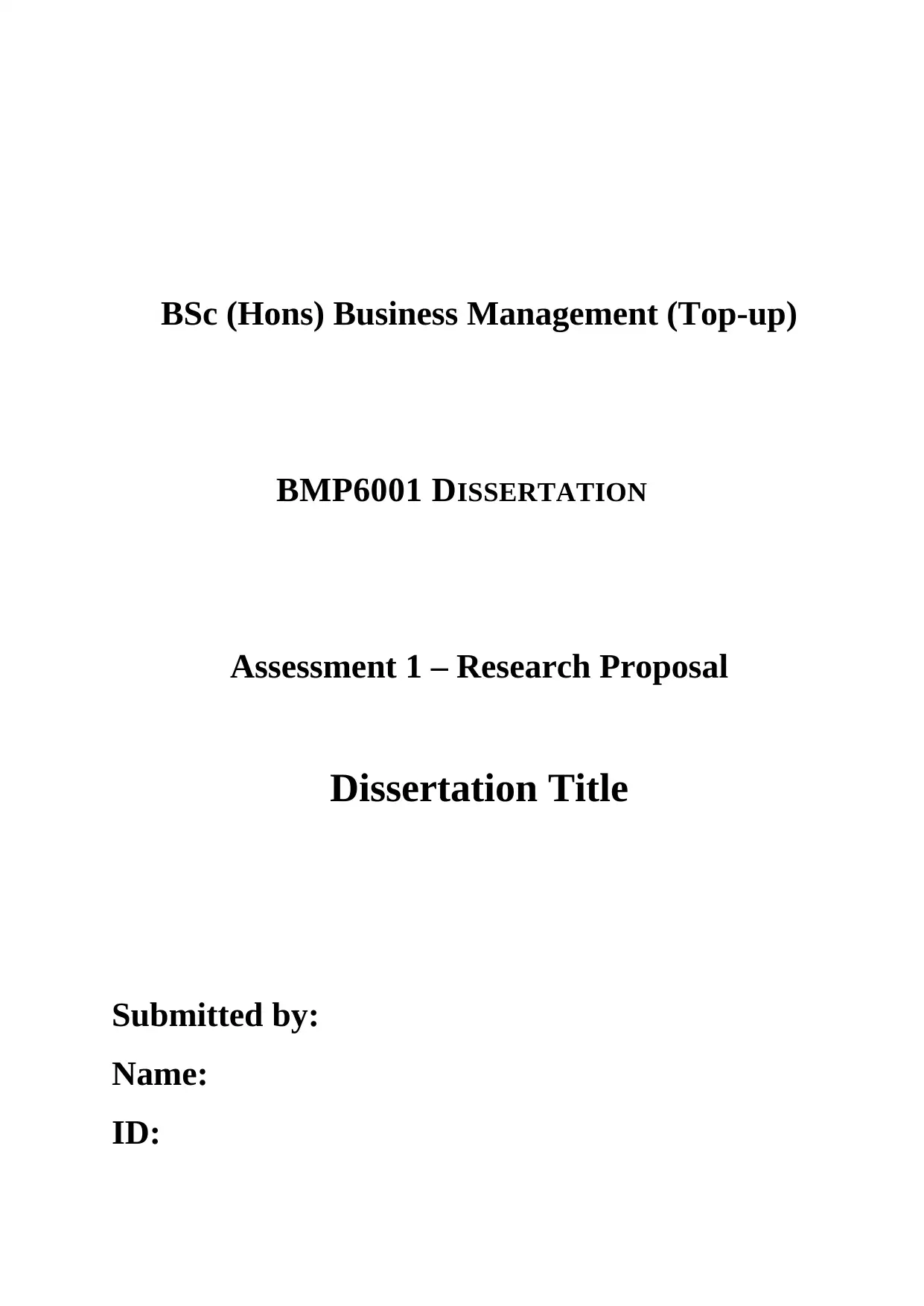
BSc (Hons) Business Management (Top-up)
BMP6001 DISSERTATION
Assessment 1 – Research Proposal
Dissertation Title
Submitted by:
Name:
ID:
BMP6001 DISSERTATION
Assessment 1 – Research Proposal
Dissertation Title
Submitted by:
Name:
ID:
Paraphrase This Document
Need a fresh take? Get an instant paraphrase of this document with our AI Paraphraser
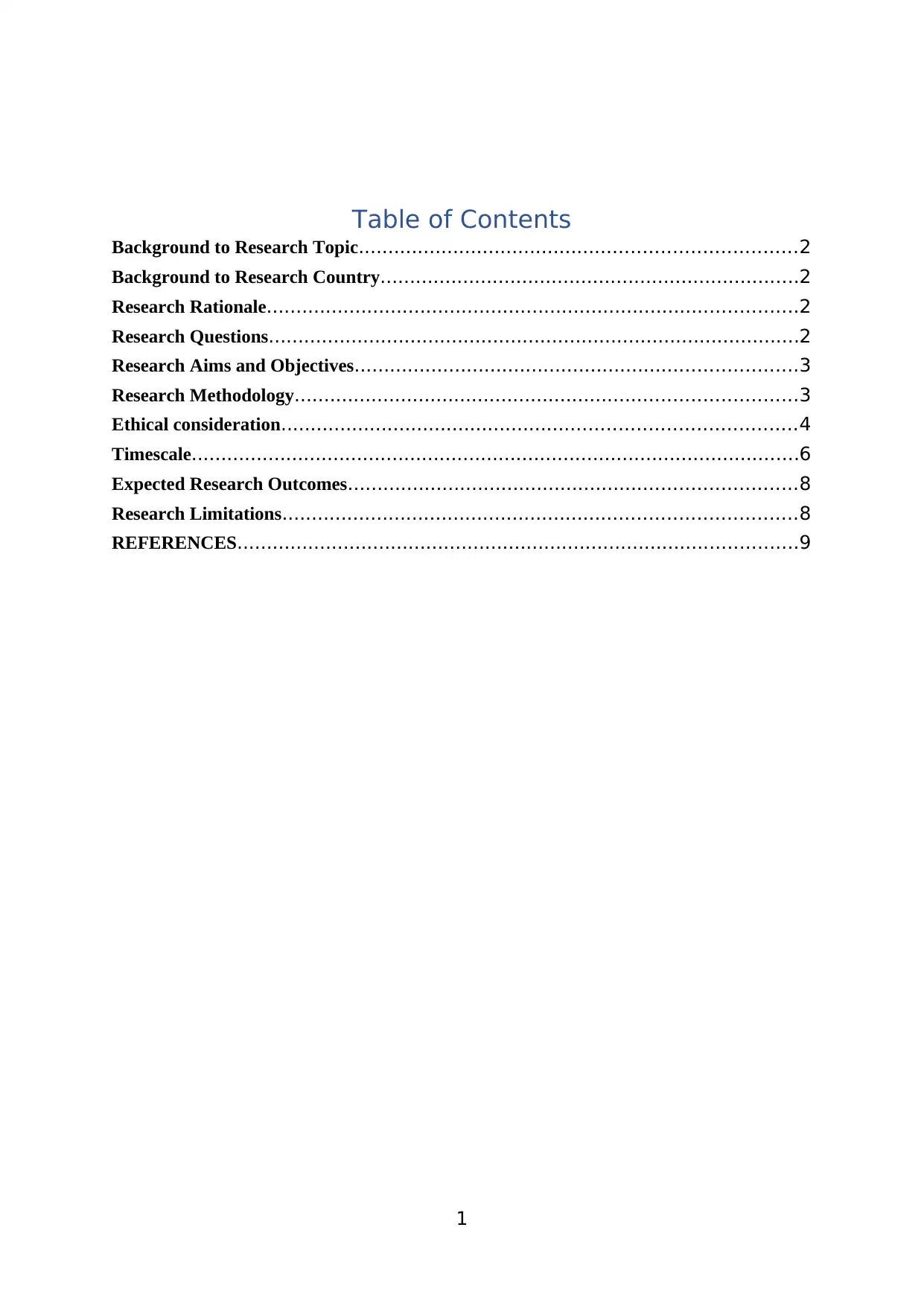
Table of Contents
Background to Research Topic..........................................................................2
Background to Research Country.......................................................................2
Research Rationale..........................................................................................2
Research Questions..........................................................................................2
Research Aims and Objectives...........................................................................3
Research Methodology.....................................................................................3
Ethical consideration.......................................................................................4
Timescale.......................................................................................................6
Expected Research Outcomes............................................................................8
Research Limitations.......................................................................................8
REFERENCES...............................................................................................9
1
Background to Research Topic..........................................................................2
Background to Research Country.......................................................................2
Research Rationale..........................................................................................2
Research Questions..........................................................................................2
Research Aims and Objectives...........................................................................3
Research Methodology.....................................................................................3
Ethical consideration.......................................................................................4
Timescale.......................................................................................................6
Expected Research Outcomes............................................................................8
Research Limitations.......................................................................................8
REFERENCES...............................................................................................9
1
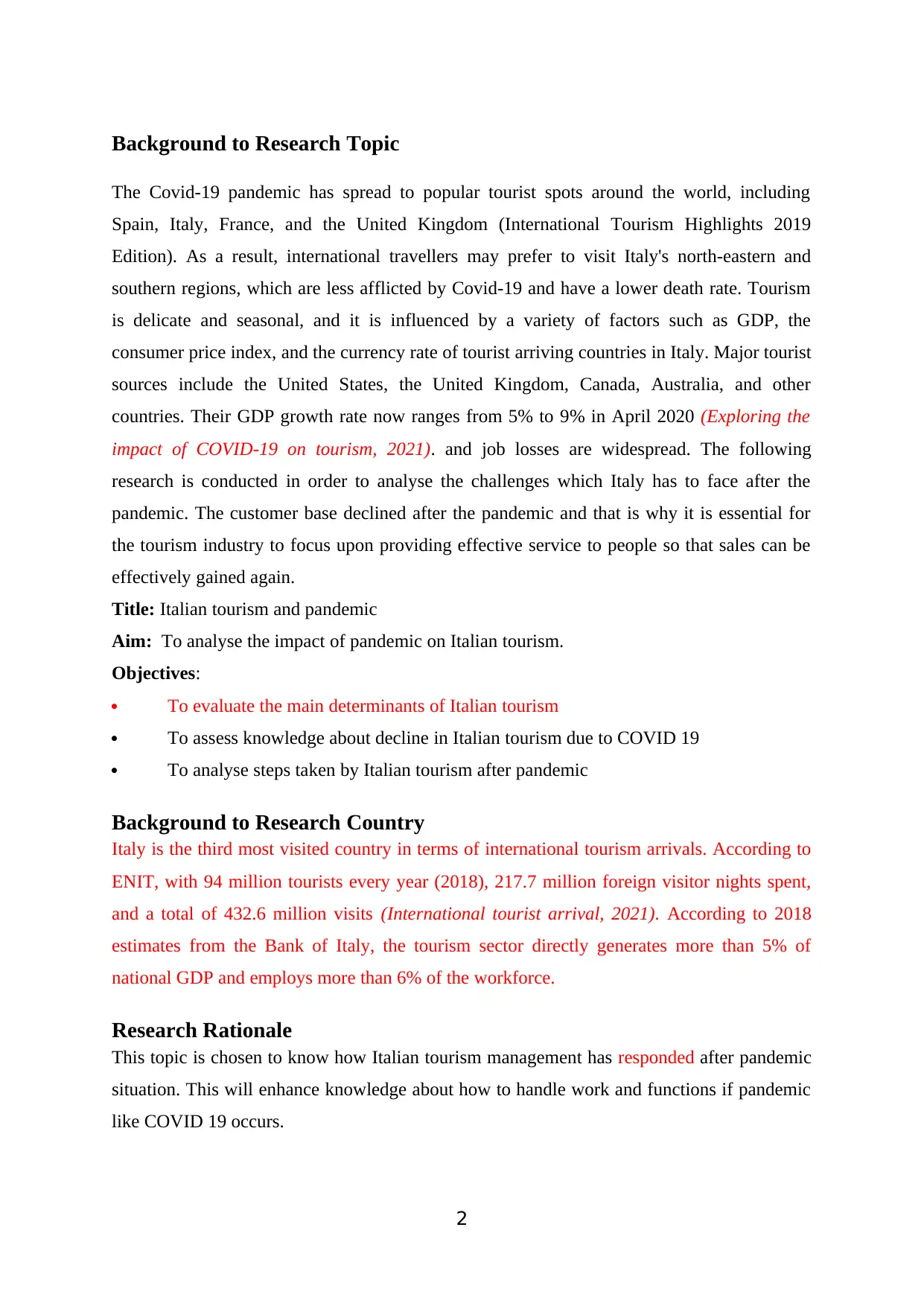
Background to Research Topic
The Covid-19 pandemic has spread to popular tourist spots around the world, including
Spain, Italy, France, and the United Kingdom (International Tourism Highlights 2019
Edition). As a result, international travellers may prefer to visit Italy's north-eastern and
southern regions, which are less afflicted by Covid-19 and have a lower death rate. Tourism
is delicate and seasonal, and it is influenced by a variety of factors such as GDP, the
consumer price index, and the currency rate of tourist arriving countries in Italy. Major tourist
sources include the United States, the United Kingdom, Canada, Australia, and other
countries. Their GDP growth rate now ranges from 5% to 9% in April 2020 (Exploring the
impact of COVID-19 on tourism, 2021). and job losses are widespread. The following
research is conducted in order to analyse the challenges which Italy has to face after the
pandemic. The customer base declined after the pandemic and that is why it is essential for
the tourism industry to focus upon providing effective service to people so that sales can be
effectively gained again.
Title: Italian tourism and pandemic
Aim: To analyse the impact of pandemic on Italian tourism.
Objectives:
To evaluate the main determinants of Italian tourism
To assess knowledge about decline in Italian tourism due to COVID 19
To analyse steps taken by Italian tourism after pandemic
Background to Research Country
Italy is the third most visited country in terms of international tourism arrivals. According to
ENIT, with 94 million tourists every year (2018), 217.7 million foreign visitor nights spent,
and a total of 432.6 million visits (International tourist arrival, 2021). According to 2018
estimates from the Bank of Italy, the tourism sector directly generates more than 5% of
national GDP and employs more than 6% of the workforce.
Research Rationale
This topic is chosen to know how Italian tourism management has responded after pandemic
situation. This will enhance knowledge about how to handle work and functions if pandemic
like COVID 19 occurs.
2
The Covid-19 pandemic has spread to popular tourist spots around the world, including
Spain, Italy, France, and the United Kingdom (International Tourism Highlights 2019
Edition). As a result, international travellers may prefer to visit Italy's north-eastern and
southern regions, which are less afflicted by Covid-19 and have a lower death rate. Tourism
is delicate and seasonal, and it is influenced by a variety of factors such as GDP, the
consumer price index, and the currency rate of tourist arriving countries in Italy. Major tourist
sources include the United States, the United Kingdom, Canada, Australia, and other
countries. Their GDP growth rate now ranges from 5% to 9% in April 2020 (Exploring the
impact of COVID-19 on tourism, 2021). and job losses are widespread. The following
research is conducted in order to analyse the challenges which Italy has to face after the
pandemic. The customer base declined after the pandemic and that is why it is essential for
the tourism industry to focus upon providing effective service to people so that sales can be
effectively gained again.
Title: Italian tourism and pandemic
Aim: To analyse the impact of pandemic on Italian tourism.
Objectives:
To evaluate the main determinants of Italian tourism
To assess knowledge about decline in Italian tourism due to COVID 19
To analyse steps taken by Italian tourism after pandemic
Background to Research Country
Italy is the third most visited country in terms of international tourism arrivals. According to
ENIT, with 94 million tourists every year (2018), 217.7 million foreign visitor nights spent,
and a total of 432.6 million visits (International tourist arrival, 2021). According to 2018
estimates from the Bank of Italy, the tourism sector directly generates more than 5% of
national GDP and employs more than 6% of the workforce.
Research Rationale
This topic is chosen to know how Italian tourism management has responded after pandemic
situation. This will enhance knowledge about how to handle work and functions if pandemic
like COVID 19 occurs.
2
⊘ This is a preview!⊘
Do you want full access?
Subscribe today to unlock all pages.

Trusted by 1+ million students worldwide
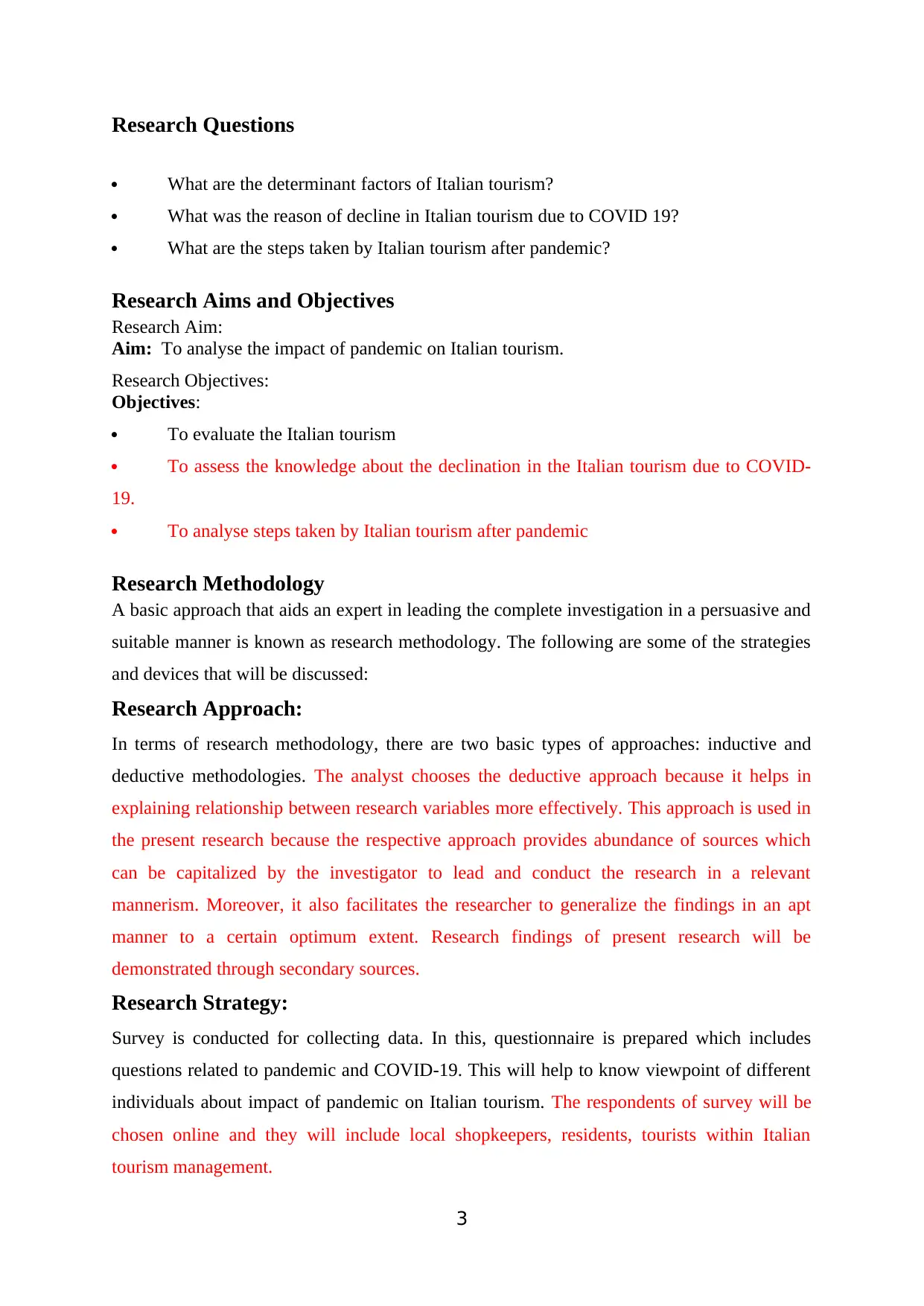
Research Questions
What are the determinant factors of Italian tourism?
What was the reason of decline in Italian tourism due to COVID 19?
What are the steps taken by Italian tourism after pandemic?
Research Aims and Objectives
Research Aim:
Aim: To analyse the impact of pandemic on Italian tourism.
Research Objectives:
Objectives:
To evaluate the Italian tourism
To assess the knowledge about the declination in the Italian tourism due to COVID-
19.
To analyse steps taken by Italian tourism after pandemic
Research Methodology
A basic approach that aids an expert in leading the complete investigation in a persuasive and
suitable manner is known as research methodology. The following are some of the strategies
and devices that will be discussed:
Research Approach:
In terms of research methodology, there are two basic types of approaches: inductive and
deductive methodologies. The analyst chooses the deductive approach because it helps in
explaining relationship between research variables more effectively. This approach is used in
the present research because the respective approach provides abundance of sources which
can be capitalized by the investigator to lead and conduct the research in a relevant
mannerism. Moreover, it also facilitates the researcher to generalize the findings in an apt
manner to a certain optimum extent. Research findings of present research will be
demonstrated through secondary sources.
Research Strategy:
Survey is conducted for collecting data. In this, questionnaire is prepared which includes
questions related to pandemic and COVID-19. This will help to know viewpoint of different
individuals about impact of pandemic on Italian tourism. The respondents of survey will be
chosen online and they will include local shopkeepers, residents, tourists within Italian
tourism management.
3
What are the determinant factors of Italian tourism?
What was the reason of decline in Italian tourism due to COVID 19?
What are the steps taken by Italian tourism after pandemic?
Research Aims and Objectives
Research Aim:
Aim: To analyse the impact of pandemic on Italian tourism.
Research Objectives:
Objectives:
To evaluate the Italian tourism
To assess the knowledge about the declination in the Italian tourism due to COVID-
19.
To analyse steps taken by Italian tourism after pandemic
Research Methodology
A basic approach that aids an expert in leading the complete investigation in a persuasive and
suitable manner is known as research methodology. The following are some of the strategies
and devices that will be discussed:
Research Approach:
In terms of research methodology, there are two basic types of approaches: inductive and
deductive methodologies. The analyst chooses the deductive approach because it helps in
explaining relationship between research variables more effectively. This approach is used in
the present research because the respective approach provides abundance of sources which
can be capitalized by the investigator to lead and conduct the research in a relevant
mannerism. Moreover, it also facilitates the researcher to generalize the findings in an apt
manner to a certain optimum extent. Research findings of present research will be
demonstrated through secondary sources.
Research Strategy:
Survey is conducted for collecting data. In this, questionnaire is prepared which includes
questions related to pandemic and COVID-19. This will help to know viewpoint of different
individuals about impact of pandemic on Italian tourism. The respondents of survey will be
chosen online and they will include local shopkeepers, residents, tourists within Italian
tourism management.
3
Paraphrase This Document
Need a fresh take? Get an instant paraphrase of this document with our AI Paraphraser
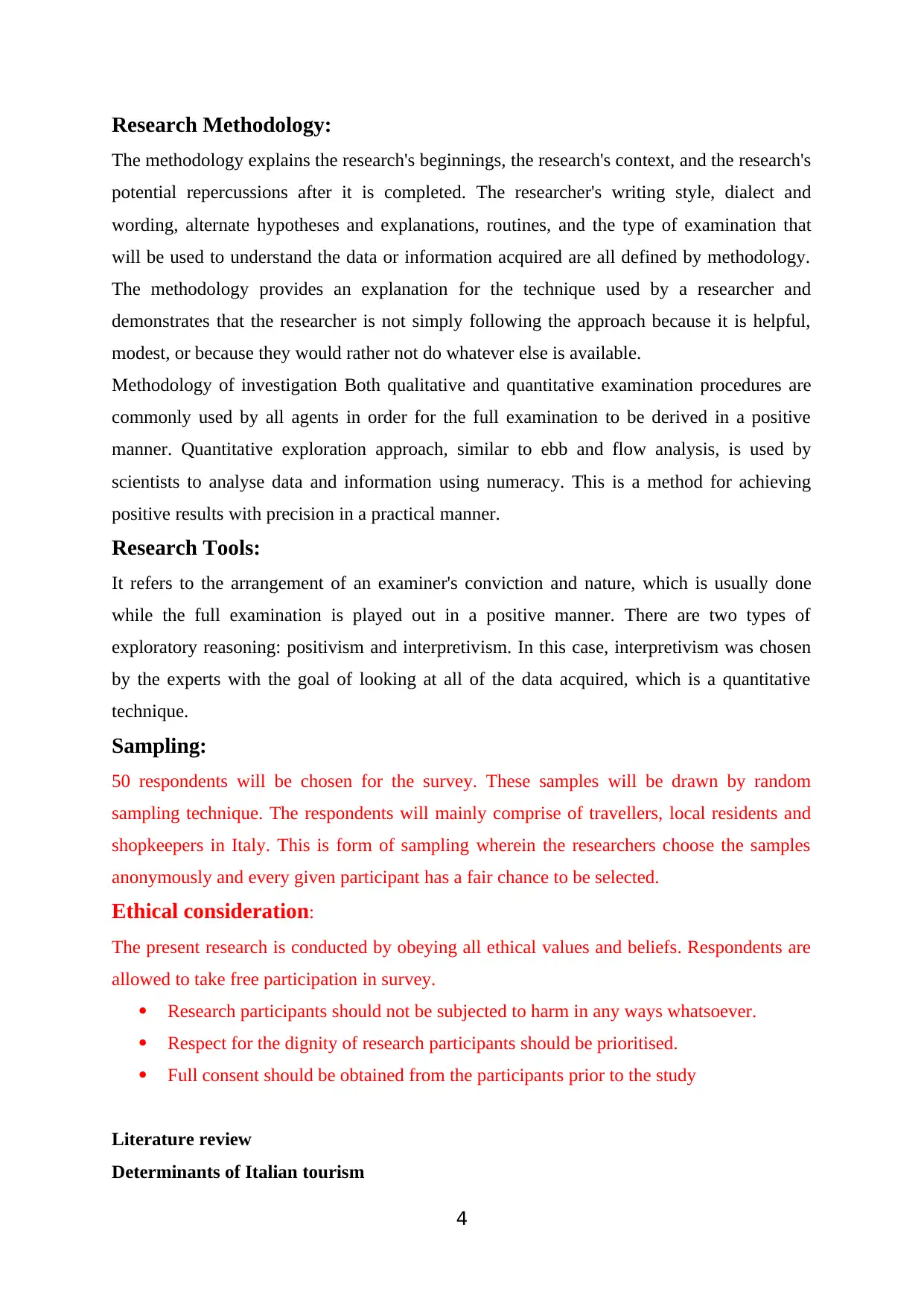
Research Methodology:
The methodology explains the research's beginnings, the research's context, and the research's
potential repercussions after it is completed. The researcher's writing style, dialect and
wording, alternate hypotheses and explanations, routines, and the type of examination that
will be used to understand the data or information acquired are all defined by methodology.
The methodology provides an explanation for the technique used by a researcher and
demonstrates that the researcher is not simply following the approach because it is helpful,
modest, or because they would rather not do whatever else is available.
Methodology of investigation Both qualitative and quantitative examination procedures are
commonly used by all agents in order for the full examination to be derived in a positive
manner. Quantitative exploration approach, similar to ebb and flow analysis, is used by
scientists to analyse data and information using numeracy. This is a method for achieving
positive results with precision in a practical manner.
Research Tools:
It refers to the arrangement of an examiner's conviction and nature, which is usually done
while the full examination is played out in a positive manner. There are two types of
exploratory reasoning: positivism and interpretivism. In this case, interpretivism was chosen
by the experts with the goal of looking at all of the data acquired, which is a quantitative
technique.
Sampling:
50 respondents will be chosen for the survey. These samples will be drawn by random
sampling technique. The respondents will mainly comprise of travellers, local residents and
shopkeepers in Italy. This is form of sampling wherein the researchers choose the samples
anonymously and every given participant has a fair chance to be selected.
Ethical consideration:
The present research is conducted by obeying all ethical values and beliefs. Respondents are
allowed to take free participation in survey.
Research participants should not be subjected to harm in any ways whatsoever.
Respect for the dignity of research participants should be prioritised.
Full consent should be obtained from the participants prior to the study
Literature review
Determinants of Italian tourism
4
The methodology explains the research's beginnings, the research's context, and the research's
potential repercussions after it is completed. The researcher's writing style, dialect and
wording, alternate hypotheses and explanations, routines, and the type of examination that
will be used to understand the data or information acquired are all defined by methodology.
The methodology provides an explanation for the technique used by a researcher and
demonstrates that the researcher is not simply following the approach because it is helpful,
modest, or because they would rather not do whatever else is available.
Methodology of investigation Both qualitative and quantitative examination procedures are
commonly used by all agents in order for the full examination to be derived in a positive
manner. Quantitative exploration approach, similar to ebb and flow analysis, is used by
scientists to analyse data and information using numeracy. This is a method for achieving
positive results with precision in a practical manner.
Research Tools:
It refers to the arrangement of an examiner's conviction and nature, which is usually done
while the full examination is played out in a positive manner. There are two types of
exploratory reasoning: positivism and interpretivism. In this case, interpretivism was chosen
by the experts with the goal of looking at all of the data acquired, which is a quantitative
technique.
Sampling:
50 respondents will be chosen for the survey. These samples will be drawn by random
sampling technique. The respondents will mainly comprise of travellers, local residents and
shopkeepers in Italy. This is form of sampling wherein the researchers choose the samples
anonymously and every given participant has a fair chance to be selected.
Ethical consideration:
The present research is conducted by obeying all ethical values and beliefs. Respondents are
allowed to take free participation in survey.
Research participants should not be subjected to harm in any ways whatsoever.
Respect for the dignity of research participants should be prioritised.
Full consent should be obtained from the participants prior to the study
Literature review
Determinants of Italian tourism
4
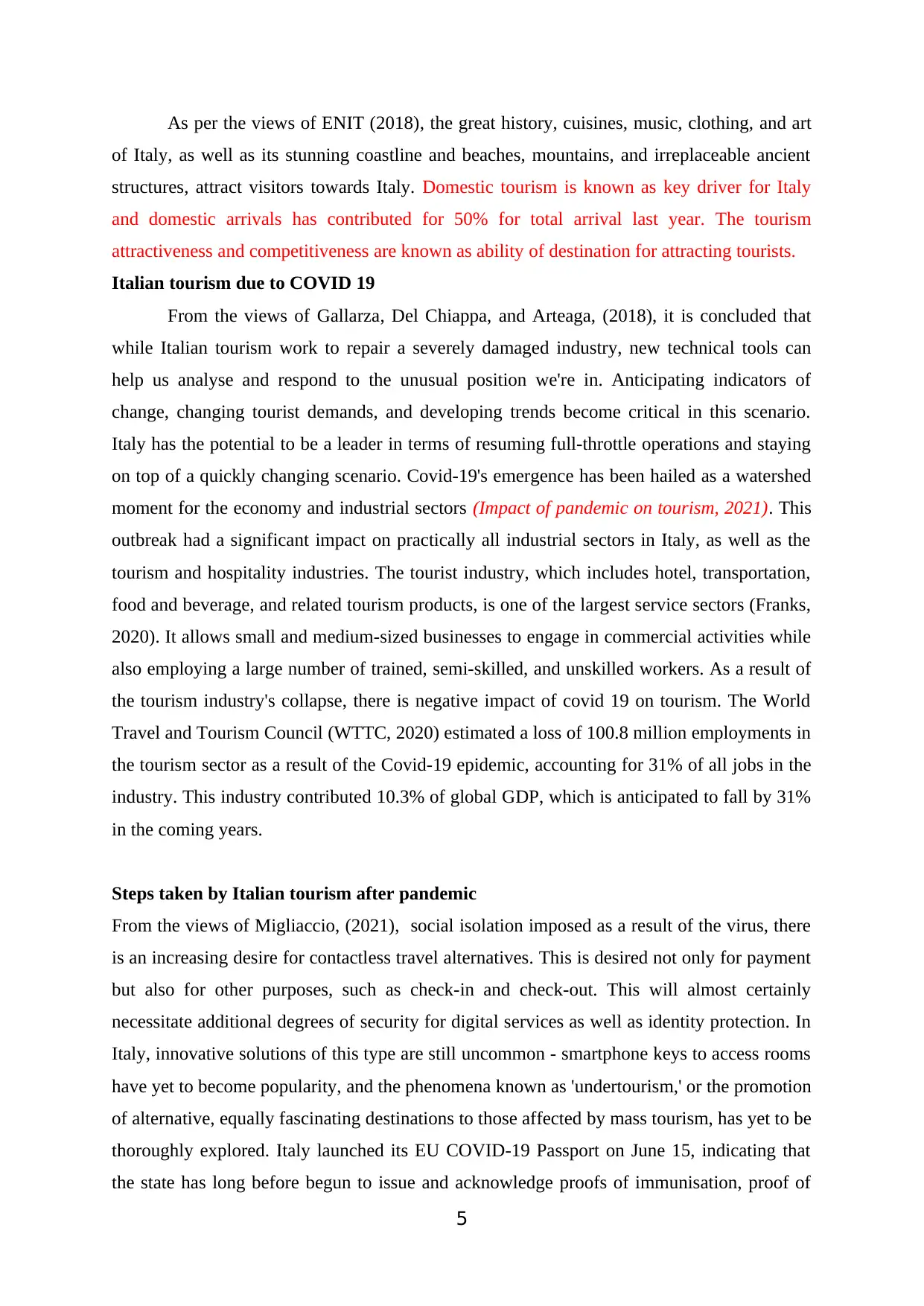
As per the views of ENIT (2018), the great history, cuisines, music, clothing, and art
of Italy, as well as its stunning coastline and beaches, mountains, and irreplaceable ancient
structures, attract visitors towards Italy. Domestic tourism is known as key driver for Italy
and domestic arrivals has contributed for 50% for total arrival last year. The tourism
attractiveness and competitiveness are known as ability of destination for attracting tourists.
Italian tourism due to COVID 19
From the views of Gallarza, Del Chiappa, and Arteaga, (2018), it is concluded that
while Italian tourism work to repair a severely damaged industry, new technical tools can
help us analyse and respond to the unusual position we're in. Anticipating indicators of
change, changing tourist demands, and developing trends become critical in this scenario.
Italy has the potential to be a leader in terms of resuming full-throttle operations and staying
on top of a quickly changing scenario. Covid-19's emergence has been hailed as a watershed
moment for the economy and industrial sectors (Impact of pandemic on tourism, 2021). This
outbreak had a significant impact on practically all industrial sectors in Italy, as well as the
tourism and hospitality industries. The tourist industry, which includes hotel, transportation,
food and beverage, and related tourism products, is one of the largest service sectors (Franks,
2020). It allows small and medium-sized businesses to engage in commercial activities while
also employing a large number of trained, semi-skilled, and unskilled workers. As a result of
the tourism industry's collapse, there is negative impact of covid 19 on tourism. The World
Travel and Tourism Council (WTTC, 2020) estimated a loss of 100.8 million employments in
the tourism sector as a result of the Covid-19 epidemic, accounting for 31% of all jobs in the
industry. This industry contributed 10.3% of global GDP, which is anticipated to fall by 31%
in the coming years.
Steps taken by Italian tourism after pandemic
From the views of Migliaccio, (2021), social isolation imposed as a result of the virus, there
is an increasing desire for contactless travel alternatives. This is desired not only for payment
but also for other purposes, such as check-in and check-out. This will almost certainly
necessitate additional degrees of security for digital services as well as identity protection. In
Italy, innovative solutions of this type are still uncommon - smartphone keys to access rooms
have yet to become popularity, and the phenomena known as 'undertourism,' or the promotion
of alternative, equally fascinating destinations to those affected by mass tourism, has yet to be
thoroughly explored. Italy launched its EU COVID-19 Passport on June 15, indicating that
the state has long before begun to issue and acknowledge proofs of immunisation, proof of
5
of Italy, as well as its stunning coastline and beaches, mountains, and irreplaceable ancient
structures, attract visitors towards Italy. Domestic tourism is known as key driver for Italy
and domestic arrivals has contributed for 50% for total arrival last year. The tourism
attractiveness and competitiveness are known as ability of destination for attracting tourists.
Italian tourism due to COVID 19
From the views of Gallarza, Del Chiappa, and Arteaga, (2018), it is concluded that
while Italian tourism work to repair a severely damaged industry, new technical tools can
help us analyse and respond to the unusual position we're in. Anticipating indicators of
change, changing tourist demands, and developing trends become critical in this scenario.
Italy has the potential to be a leader in terms of resuming full-throttle operations and staying
on top of a quickly changing scenario. Covid-19's emergence has been hailed as a watershed
moment for the economy and industrial sectors (Impact of pandemic on tourism, 2021). This
outbreak had a significant impact on practically all industrial sectors in Italy, as well as the
tourism and hospitality industries. The tourist industry, which includes hotel, transportation,
food and beverage, and related tourism products, is one of the largest service sectors (Franks,
2020). It allows small and medium-sized businesses to engage in commercial activities while
also employing a large number of trained, semi-skilled, and unskilled workers. As a result of
the tourism industry's collapse, there is negative impact of covid 19 on tourism. The World
Travel and Tourism Council (WTTC, 2020) estimated a loss of 100.8 million employments in
the tourism sector as a result of the Covid-19 epidemic, accounting for 31% of all jobs in the
industry. This industry contributed 10.3% of global GDP, which is anticipated to fall by 31%
in the coming years.
Steps taken by Italian tourism after pandemic
From the views of Migliaccio, (2021), social isolation imposed as a result of the virus, there
is an increasing desire for contactless travel alternatives. This is desired not only for payment
but also for other purposes, such as check-in and check-out. This will almost certainly
necessitate additional degrees of security for digital services as well as identity protection. In
Italy, innovative solutions of this type are still uncommon - smartphone keys to access rooms
have yet to become popularity, and the phenomena known as 'undertourism,' or the promotion
of alternative, equally fascinating destinations to those affected by mass tourism, has yet to be
thoroughly explored. Italy launched its EU COVID-19 Passport on June 15, indicating that
the state has long before begun to issue and acknowledge proofs of immunisation, proof of
5
⊘ This is a preview!⊘
Do you want full access?
Subscribe today to unlock all pages.

Trusted by 1+ million students worldwide
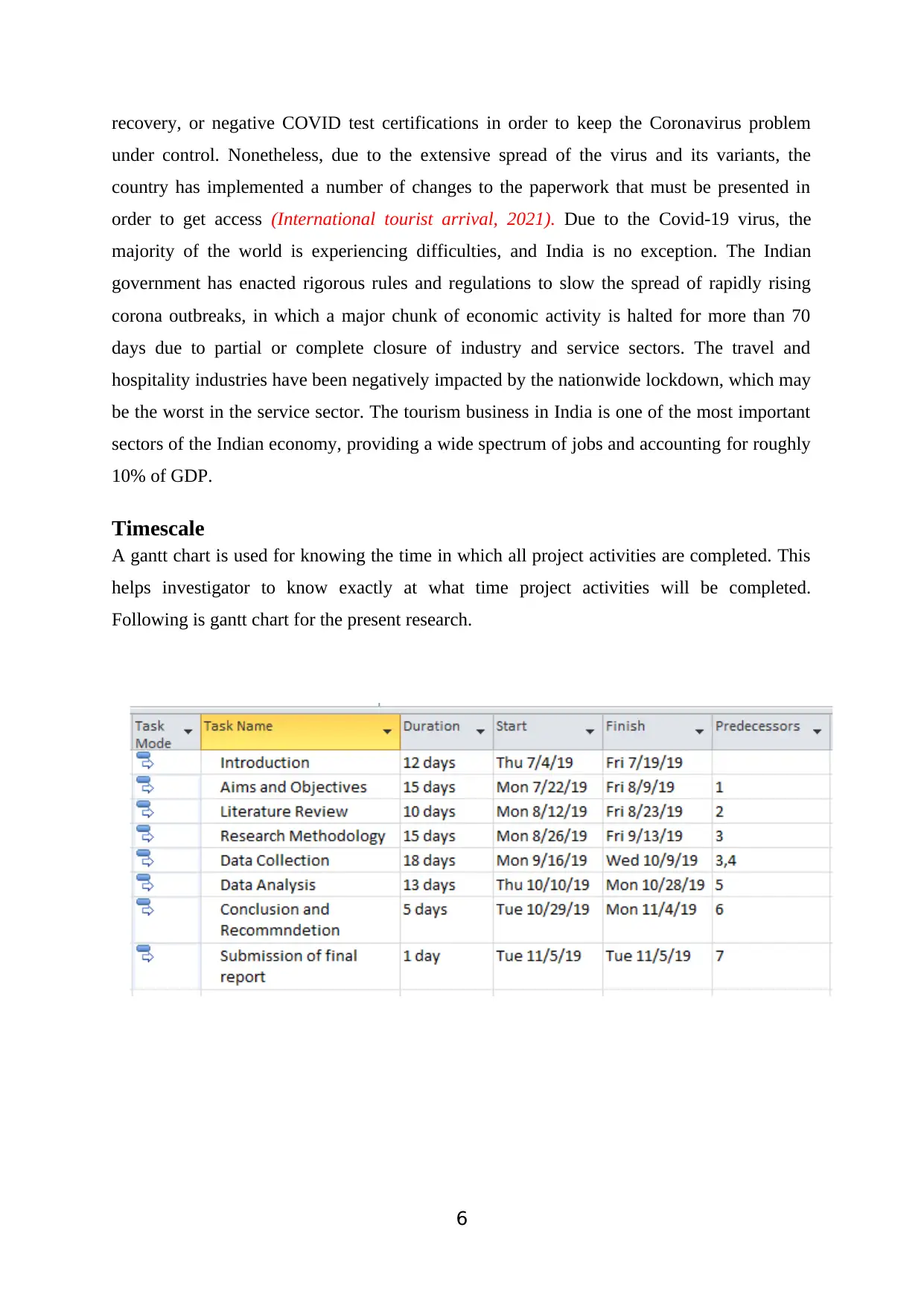
recovery, or negative COVID test certifications in order to keep the Coronavirus problem
under control. Nonetheless, due to the extensive spread of the virus and its variants, the
country has implemented a number of changes to the paperwork that must be presented in
order to get access (International tourist arrival, 2021). Due to the Covid-19 virus, the
majority of the world is experiencing difficulties, and India is no exception. The Indian
government has enacted rigorous rules and regulations to slow the spread of rapidly rising
corona outbreaks, in which a major chunk of economic activity is halted for more than 70
days due to partial or complete closure of industry and service sectors. The travel and
hospitality industries have been negatively impacted by the nationwide lockdown, which may
be the worst in the service sector. The tourism business in India is one of the most important
sectors of the Indian economy, providing a wide spectrum of jobs and accounting for roughly
10% of GDP.
Timescale
A gantt chart is used for knowing the time in which all project activities are completed. This
helps investigator to know exactly at what time project activities will be completed.
Following is gantt chart for the present research.
6
under control. Nonetheless, due to the extensive spread of the virus and its variants, the
country has implemented a number of changes to the paperwork that must be presented in
order to get access (International tourist arrival, 2021). Due to the Covid-19 virus, the
majority of the world is experiencing difficulties, and India is no exception. The Indian
government has enacted rigorous rules and regulations to slow the spread of rapidly rising
corona outbreaks, in which a major chunk of economic activity is halted for more than 70
days due to partial or complete closure of industry and service sectors. The travel and
hospitality industries have been negatively impacted by the nationwide lockdown, which may
be the worst in the service sector. The tourism business in India is one of the most important
sectors of the Indian economy, providing a wide spectrum of jobs and accounting for roughly
10% of GDP.
Timescale
A gantt chart is used for knowing the time in which all project activities are completed. This
helps investigator to know exactly at what time project activities will be completed.
Following is gantt chart for the present research.
6
Paraphrase This Document
Need a fresh take? Get an instant paraphrase of this document with our AI Paraphraser
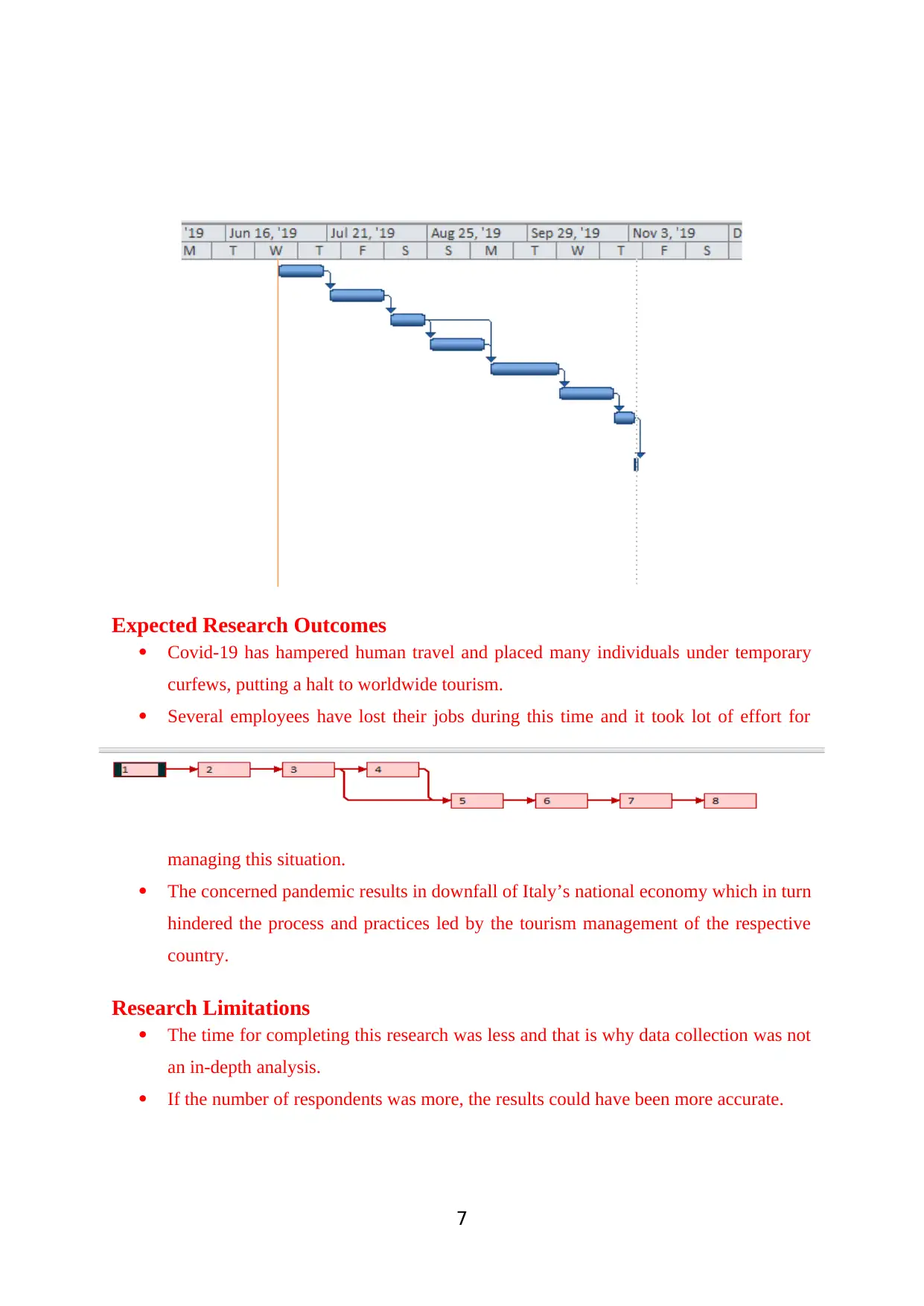
Expected Research Outcomes
Covid-19 has hampered human travel and placed many individuals under temporary
curfews, putting a halt to worldwide tourism.
Several employees have lost their jobs during this time and it took lot of effort for
managing this situation.
The concerned pandemic results in downfall of Italy’s national economy which in turn
hindered the process and practices led by the tourism management of the respective
country.
Research Limitations
The time for completing this research was less and that is why data collection was not
an in-depth analysis.
If the number of respondents was more, the results could have been more accurate.
7
Covid-19 has hampered human travel and placed many individuals under temporary
curfews, putting a halt to worldwide tourism.
Several employees have lost their jobs during this time and it took lot of effort for
managing this situation.
The concerned pandemic results in downfall of Italy’s national economy which in turn
hindered the process and practices led by the tourism management of the respective
country.
Research Limitations
The time for completing this research was less and that is why data collection was not
an in-depth analysis.
If the number of respondents was more, the results could have been more accurate.
7

8
⊘ This is a preview!⊘
Do you want full access?
Subscribe today to unlock all pages.

Trusted by 1+ million students worldwide
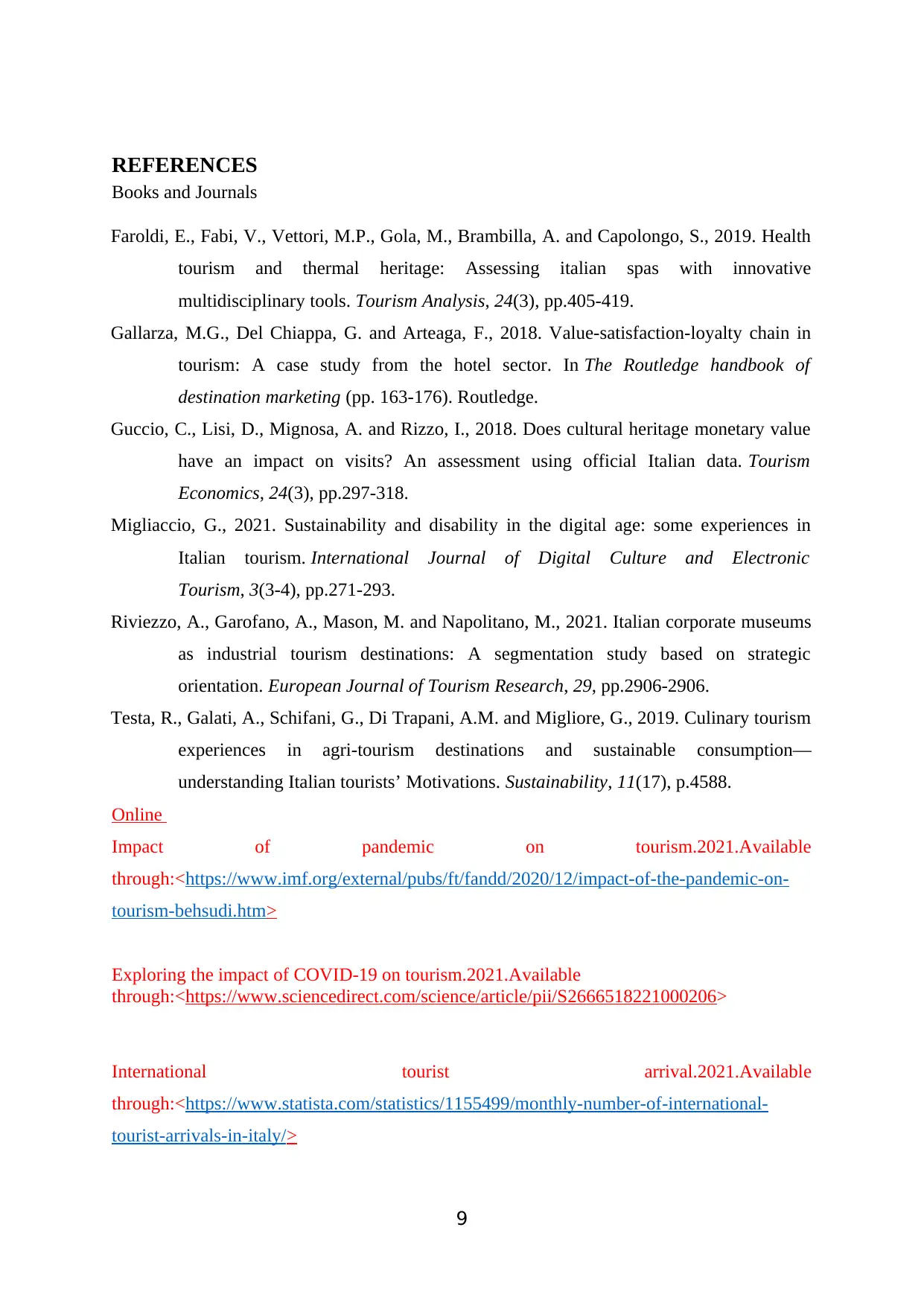
REFERENCES
Books and Journals
Faroldi, E., Fabi, V., Vettori, M.P., Gola, M., Brambilla, A. and Capolongo, S., 2019. Health
tourism and thermal heritage: Assessing italian spas with innovative
multidisciplinary tools. Tourism Analysis, 24(3), pp.405-419.
Gallarza, M.G., Del Chiappa, G. and Arteaga, F., 2018. Value-satisfaction-loyalty chain in
tourism: A case study from the hotel sector. In The Routledge handbook of
destination marketing (pp. 163-176). Routledge.
Guccio, C., Lisi, D., Mignosa, A. and Rizzo, I., 2018. Does cultural heritage monetary value
have an impact on visits? An assessment using official Italian data. Tourism
Economics, 24(3), pp.297-318.
Migliaccio, G., 2021. Sustainability and disability in the digital age: some experiences in
Italian tourism. International Journal of Digital Culture and Electronic
Tourism, 3(3-4), pp.271-293.
Riviezzo, A., Garofano, A., Mason, M. and Napolitano, M., 2021. Italian corporate museums
as industrial tourism destinations: А segmentation study based on strategic
orientation. European Journal of Tourism Research, 29, pp.2906-2906.
Testa, R., Galati, A., Schifani, G., Di Trapani, A.M. and Migliore, G., 2019. Culinary tourism
experiences in agri-tourism destinations and sustainable consumption—
understanding Italian tourists’ Motivations. Sustainability, 11(17), p.4588.
Online
Impact of pandemic on tourism.2021.Available
through:<https://www.imf.org/external/pubs/ft/fandd/2020/12/impact-of-the-pandemic-on-
tourism-behsudi.htm>
Exploring the impact of COVID-19 on tourism.2021.Available
through:<https://www.sciencedirect.com/science/article/pii/S2666518221000206>
International tourist arrival.2021.Available
through:<https://www.statista.com/statistics/1155499/monthly-number-of-international-
tourist-arrivals-in-italy/>
9
Books and Journals
Faroldi, E., Fabi, V., Vettori, M.P., Gola, M., Brambilla, A. and Capolongo, S., 2019. Health
tourism and thermal heritage: Assessing italian spas with innovative
multidisciplinary tools. Tourism Analysis, 24(3), pp.405-419.
Gallarza, M.G., Del Chiappa, G. and Arteaga, F., 2018. Value-satisfaction-loyalty chain in
tourism: A case study from the hotel sector. In The Routledge handbook of
destination marketing (pp. 163-176). Routledge.
Guccio, C., Lisi, D., Mignosa, A. and Rizzo, I., 2018. Does cultural heritage monetary value
have an impact on visits? An assessment using official Italian data. Tourism
Economics, 24(3), pp.297-318.
Migliaccio, G., 2021. Sustainability and disability in the digital age: some experiences in
Italian tourism. International Journal of Digital Culture and Electronic
Tourism, 3(3-4), pp.271-293.
Riviezzo, A., Garofano, A., Mason, M. and Napolitano, M., 2021. Italian corporate museums
as industrial tourism destinations: А segmentation study based on strategic
orientation. European Journal of Tourism Research, 29, pp.2906-2906.
Testa, R., Galati, A., Schifani, G., Di Trapani, A.M. and Migliore, G., 2019. Culinary tourism
experiences in agri-tourism destinations and sustainable consumption—
understanding Italian tourists’ Motivations. Sustainability, 11(17), p.4588.
Online
Impact of pandemic on tourism.2021.Available
through:<https://www.imf.org/external/pubs/ft/fandd/2020/12/impact-of-the-pandemic-on-
tourism-behsudi.htm>
Exploring the impact of COVID-19 on tourism.2021.Available
through:<https://www.sciencedirect.com/science/article/pii/S2666518221000206>
International tourist arrival.2021.Available
through:<https://www.statista.com/statistics/1155499/monthly-number-of-international-
tourist-arrivals-in-italy/>
9
Paraphrase This Document
Need a fresh take? Get an instant paraphrase of this document with our AI Paraphraser
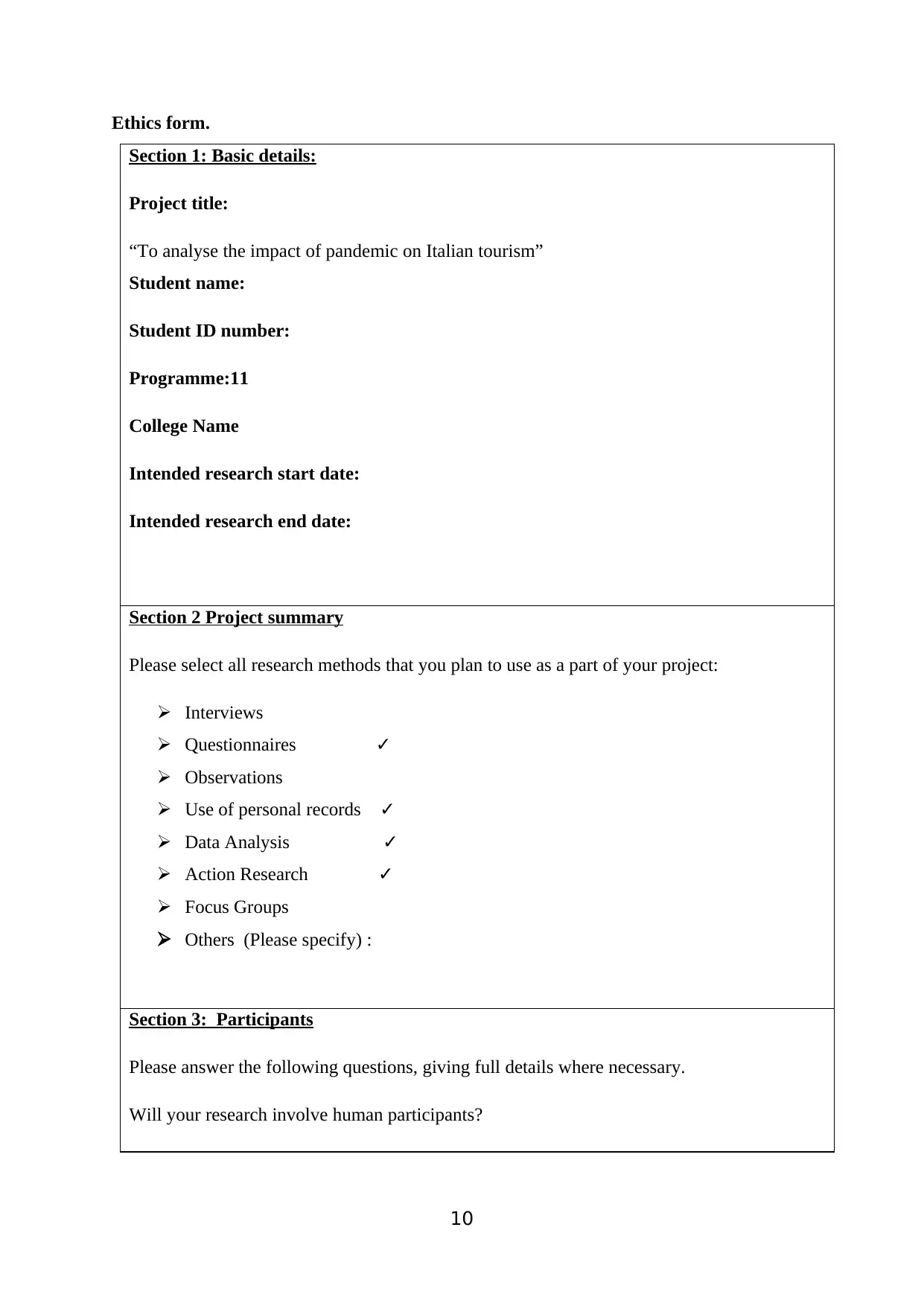
Ethics form.
Section 1: Basic details:
Project title:
“To analyse the impact of pandemic on Italian tourism”
Student name:
Student ID number:
Programme:11
College Name
Intended research start date:
Intended research end date:
Section 2 Project summary
Please select all research methods that you plan to use as a part of your project:
Interviews
Questionnaires ✓
Observations
Use of personal records ✓
Data Analysis ✓
Action Research ✓
Focus Groups
Others (Please specify) :
Section 3: Participants
Please answer the following questions, giving full details where necessary.
Will your research involve human participants?
10
Section 1: Basic details:
Project title:
“To analyse the impact of pandemic on Italian tourism”
Student name:
Student ID number:
Programme:11
College Name
Intended research start date:
Intended research end date:
Section 2 Project summary
Please select all research methods that you plan to use as a part of your project:
Interviews
Questionnaires ✓
Observations
Use of personal records ✓
Data Analysis ✓
Action Research ✓
Focus Groups
Others (Please specify) :
Section 3: Participants
Please answer the following questions, giving full details where necessary.
Will your research involve human participants?
10
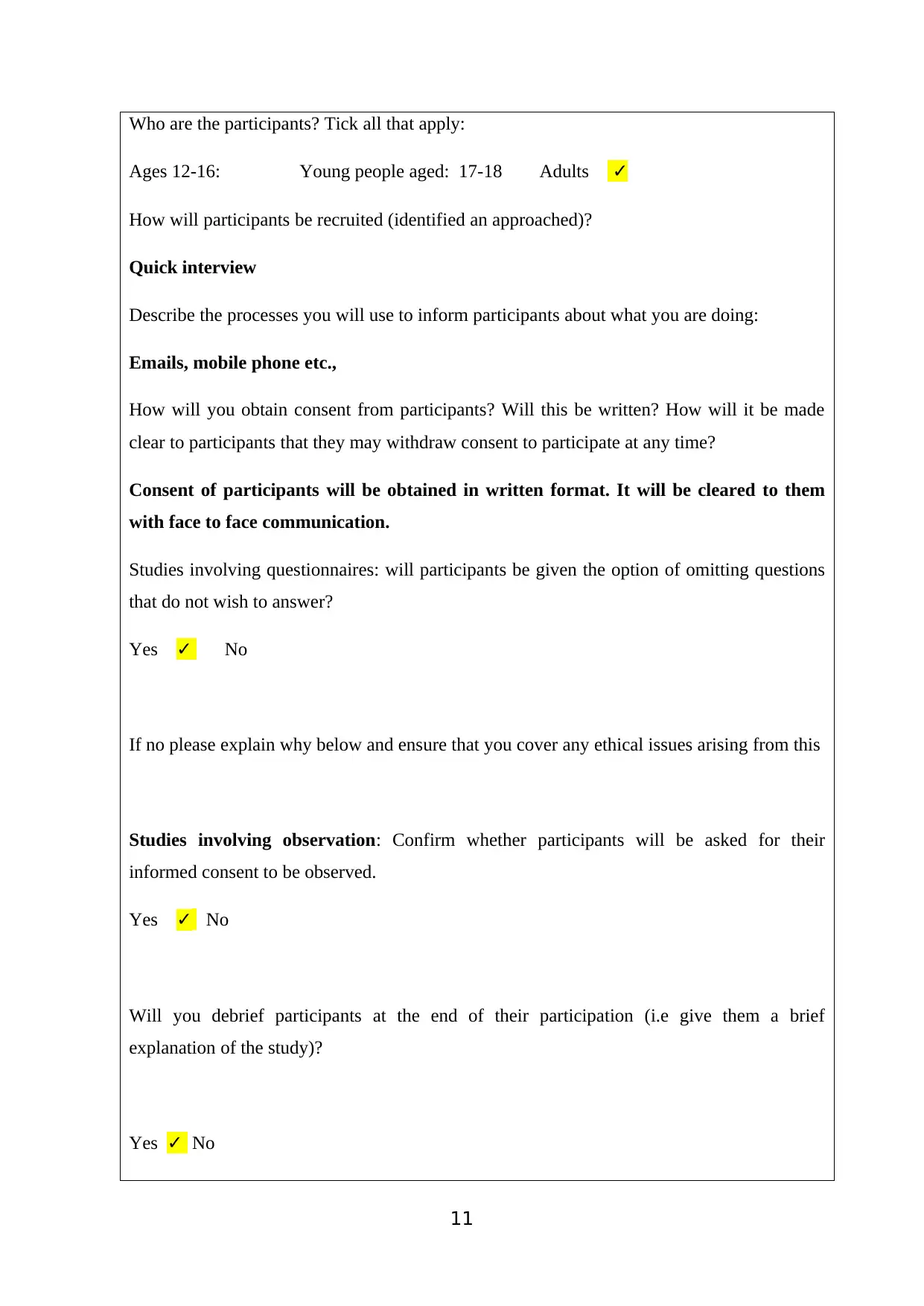
Who are the participants? Tick all that apply:
Ages 12-16: Young people aged: 17-18 Adults ✓
How will participants be recruited (identified an approached)?
Quick interview
Describe the processes you will use to inform participants about what you are doing:
Emails, mobile phone etc.,
How will you obtain consent from participants? Will this be written? How will it be made
clear to participants that they may withdraw consent to participate at any time?
Consent of participants will be obtained in written format. It will be cleared to them
with face to face communication.
Studies involving questionnaires: will participants be given the option of omitting questions
that do not wish to answer?
Yes ✓ No
If no please explain why below and ensure that you cover any ethical issues arising from this
Studies involving observation: Confirm whether participants will be asked for their
informed consent to be observed.
Yes ✓ No
Will you debrief participants at the end of their participation (i.e give them a brief
explanation of the study)?
Yes ✓ No
11
Ages 12-16: Young people aged: 17-18 Adults ✓
How will participants be recruited (identified an approached)?
Quick interview
Describe the processes you will use to inform participants about what you are doing:
Emails, mobile phone etc.,
How will you obtain consent from participants? Will this be written? How will it be made
clear to participants that they may withdraw consent to participate at any time?
Consent of participants will be obtained in written format. It will be cleared to them
with face to face communication.
Studies involving questionnaires: will participants be given the option of omitting questions
that do not wish to answer?
Yes ✓ No
If no please explain why below and ensure that you cover any ethical issues arising from this
Studies involving observation: Confirm whether participants will be asked for their
informed consent to be observed.
Yes ✓ No
Will you debrief participants at the end of their participation (i.e give them a brief
explanation of the study)?
Yes ✓ No
11
⊘ This is a preview!⊘
Do you want full access?
Subscribe today to unlock all pages.

Trusted by 1+ million students worldwide
1 out of 15
Related Documents
Your All-in-One AI-Powered Toolkit for Academic Success.
+13062052269
info@desklib.com
Available 24*7 on WhatsApp / Email
![[object Object]](/_next/static/media/star-bottom.7253800d.svg)
Unlock your academic potential
Copyright © 2020–2025 A2Z Services. All Rights Reserved. Developed and managed by ZUCOL.




